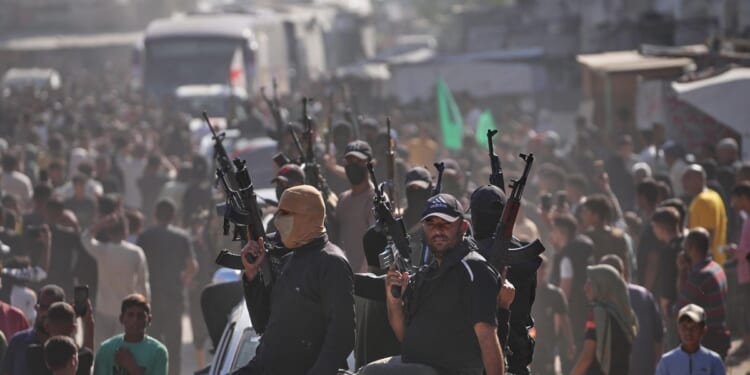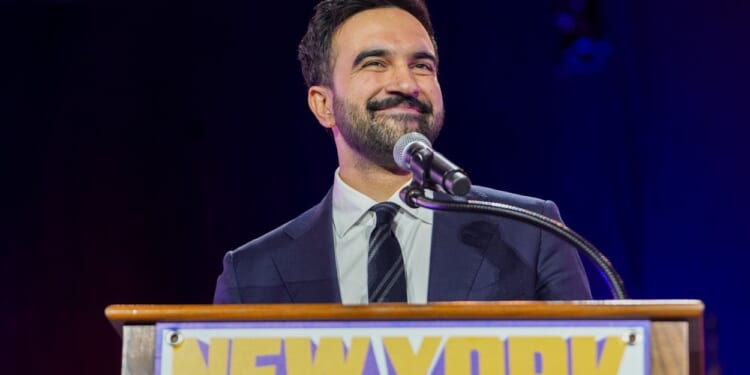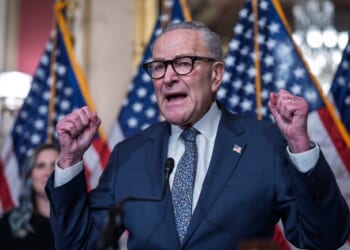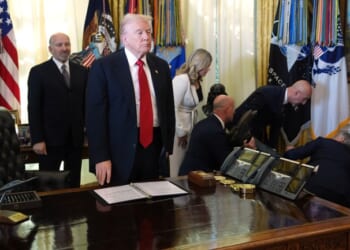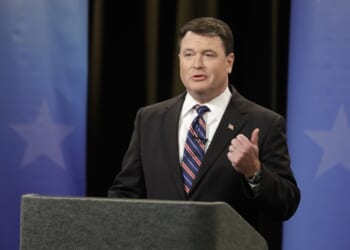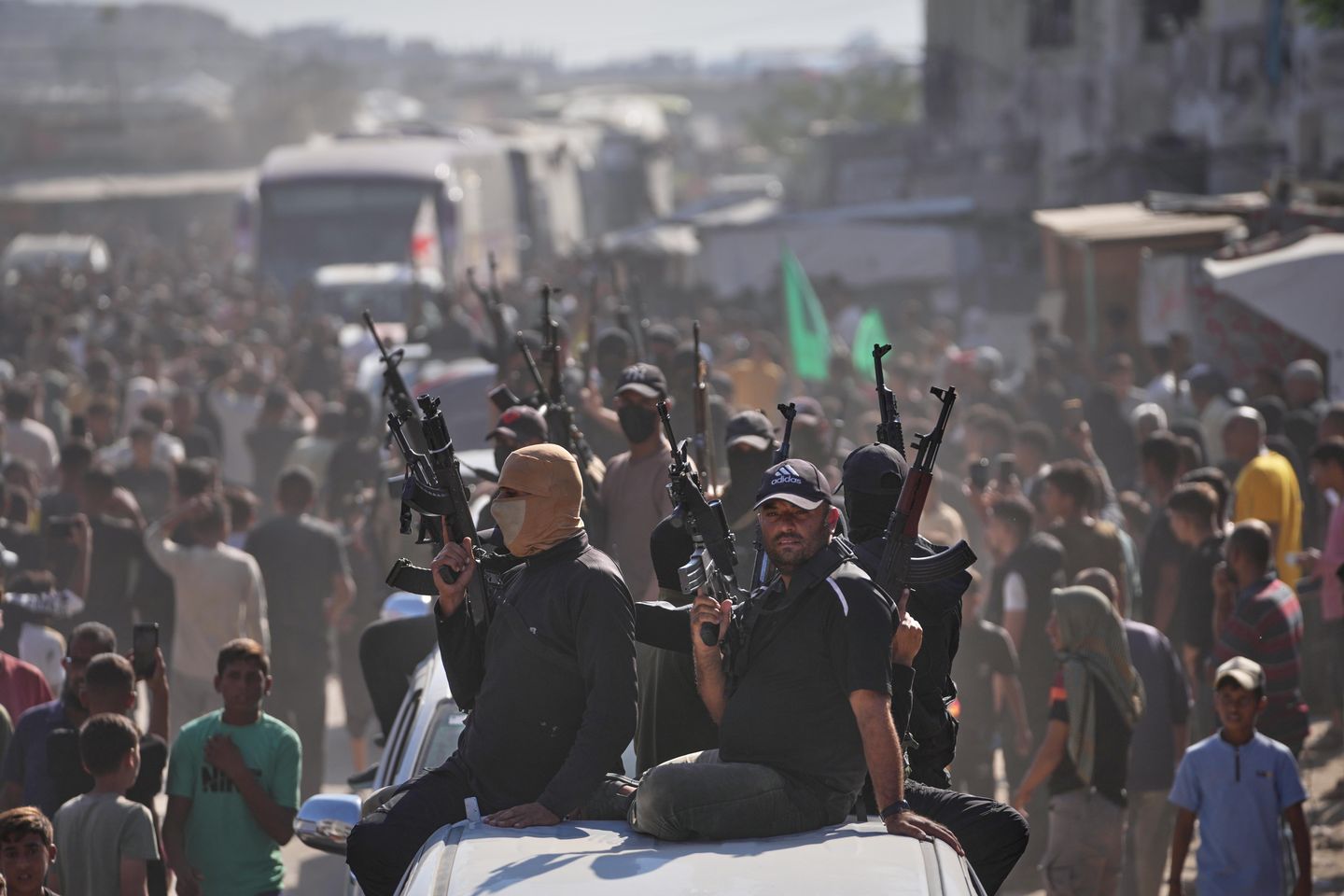
CAIRO — Gaza’s fragile ceasefire is unraveling into internal warfare as armed clan militias challenge the remnants of a still-lethal Hamas, which has responded with a brutal crackdown that has left more than 30 people dead, including at least eight publicly executed.
From the northern ruins of Beit Lahia to the southern border with Egypt, family-based militias known as hamulas have emerged from the shadows, seized territory, controlled aid distribution and openly defied Hamas security forces weakened by months of Israeli bombardment.
“What’s happening now is an attempt by remnants of Hamas’s militant elements to reassert control and prove their presence on the Palestinian scene,” Hussam al-Astl, leader of the Counter-Terrorism Strike Force militia in Khan Younis, told The Washington Times. “After losing nearly all of their military leaders and equipment during the war, they’re trying to show that they still dominate the Gaza Strip.”
Mr. al-Astl said his fighters began operating independently after “deciding to organize in order to address the injustices suffered by our people in Gaza. We felt it was our duty to help ourselves and our community after losing faith in everyone else — so we decided to act on our own.”
Many of these clan rivalries predate Hamas’s 2007 takeover of Gaza but were kept in check by centralized authority. The war has decimated that authority and opened space for outside patronage to reignite old feuds with ferocity. Analysts note that some families now have weapons caches that rival those of residual Hamas units.
The chaos threatens to derail President Trump’s ambitious 20-point peace framework and raises the specter of Gaza fracturing into a patchwork of clan fiefdoms backed by competing foreign powers.
Clan warfare erupts
On Thursday, fresh clashes erupted between Hamas forces and the Abu Wardah clan near Gaza City’s port, leaving at least five dead. The confrontation is part of a wider pattern of violence that has engulfed the Strip since Israeli forces began withdrawing from key areas.
The most violent flashpoint came in battles with the Doghmush clan in Gaza City, where at least 27 people died, including eight Hamas operatives. Hamas accused the clan of collaborating with Israel and maintaining links to rival armed networks.
“Children are screaming and dying, they are burning our houses,” a relative of the Doghmush clan told the Israeli news portal Ynet. “We are trapped. I don’t know how they entered with all kinds of weapons. Where were they when the Israelis were here?”
Another member added: “They arrested all the youths, lined them up against walls, pointed weapons at their heads. There is a massacre here.”
In Khan Younis, the Al-Mujaida clan clashed with Hamas in early October after being accused of orchestrating attacks on Hamas personnel.
As Israeli forces completed recent withdrawals, Hamas moved quickly to reassert dominance. The group issued mobilization orders calling on 7,000 security personnel to “cleanse” Gaza of outlaws and collaborators.
“Following the ceasefire agreement signed in Sharm el-Sheikh between Israel and Hamas, the movement began redeploying its internal security forces across the Gaza Strip — from the north to the south,” said Ali al-Awar, a lecturer at Ben-Gurion University’s Middle East Studies Department. “At the same time, Hamas launched a campaign to settle scores with those it accused of collaborating with Israel or violating its authority.”
Hamas’s Interior Ministry announced a “general amnesty period” for gang members not charged with murder. But anyone accused of aiding Israel faced execution. The ministry warned that families sheltering suspected collaborators would be “treated as complicit.”
Since the ceasefire took effect, Hamas has killed more than 30 people in clashes with rival clans and security operations. At least eight men were publicly executed in Gaza City on Monday, with videos showing masked gunmen shooting blindfolded prisoners in front of cheering crowds.
“Even before the ceasefire took effect, clashes broke out between Hamas and local clans such as the al-Majaida family in Khan Yunis,” Mr. al-Awar said. “Afterward, similar confrontations erupted with the Dughmush family. Hamas seeks to reassert its presence as both a political and military power capable of enforcing order.”
The Arrow Unit posted footage of one execution on its Telegram channel with a stark message: “This is the fate of every traitor to the homeland and to religion — the moment of the execution of the occupation’s agents from the Doghmush family.”
Mr. Trump, while aboard Air Force One, downplayed the killings, calling Hamas’s actions against “very bad gangs” acceptable and saying his administration had authorized the group to act temporarily as Gaza’s police force until a new administration forms.
After Hamas’s campaign of violence began, several clans issued statements reaffirming their loyalty while distancing themselves from “outlaws.” The al-Mujaida family released a statement declaring its “full support for the government and its security agencies” and agreed to surrender its weapons — though whether the move was voluntary or coerced remains unclear.
The Doghmush clan pushed back hard, issuing a statement expressing shock at “a distressing internal campaign targeting our innocent sons, involving killing, intimidation, torture, and burning of homes with their residents inside, without any justification.”
The family said it lost some 600 members during the war and firmly rejected “all attempts by the occupation to win it over or recruit it.”
Israel has reportedly backed or armed some anti-Hamas factions to protect aid routes and humanitarian workers. Prime Minister Benjamin Netanyahu acknowledged activating Palestinian clans opposed to Hamas, effectively signaling Israel’s willingness to cultivate proxies inside the Strip.
The most prominent is the Popular Forces, led by Yasser Abu Shabab, a Bedouin clan leader from Rafah who escaped Hamas detention after heavy bombardment in October 2023. His forces now control aid distribution at crossing points like Kerem Shalom.
The Counter-Terrorism Strike Force, led by Mr. al-Astl, claims ties to Israeli security services and reportedly received Israeli air support during clashes with Hamas. Mr. al-Astl denied receiving direct Israeli military support: “The claims that we receive support from the Israeli army are completely false. We operate through international organizations, and it is those organizations that coordinate with the Israeli side to deliver humanitarian aid to the areas under our control.”
Mr. Trump’s peace framework envisions Gaza being overseen by a foreign-supervised International Transitional Authority. The plan authorizes Hamas to maintain order temporarily — so long as it disarms completely.
If Hamas surrenders its weapons, the document suggests, the group might shift from a militant organization to a purely political movement. Hamas insists it would surrender weapons only in the context of an independent Palestinian state.
On the ground, Hamas is exploiting ambiguities in the plan, positioning its crackdowns as law enforcement and justifying executions as action against gangsters and collaborators.
But escalating bloodshed has unsettled the White House. On Thursday, Mr. Trump warned Hamas that if the violence continues, “we will have no choice but to go in and kill them.”
Hamas now faces perhaps its gravest internal test — not from Israeli firepower but from fractured authority at home. With heavy external interference from Israel, the U.S. and Gulf states, Gaza risks becoming a fragmented battlefield of foreign proxies rather than a unified territory under any central rule.
“What we are witnessing today signals the possible onset of an internal Palestinian confrontation — a slide toward civil war,” said Mansour Abo Kareem, a Gaza-based political affairs researcher. “All the conditions for such a conflict are now present. Hamas’s increasingly violent behavior toward armed groups and local families risks triggering major clashes.”
Abo Kareem warned that any transfer of power will likely come through internal conflict: “Hamas will not voluntarily surrender its weapons or its authority in Gaza. Neither Israel nor the United States can forcibly disarm the movement.”
“Hamas is currently trying to reach us in order to eliminate us, but that will not happen,” Mr. al-Astl said. “We are working for a new Gaza — one without wars. We are prepared to work with any authority that takes responsibility for the revival of Gaza. We welcome President Trump’s plan to end the war, applaud his efforts to bring peace, and we thank him.

